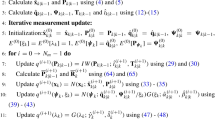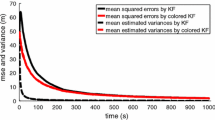Abstract
In this paper, a novel robust Student’s t-based Kalman filter (RSTKF) is proposed to solve the problem of a linear system with heavy-tailed process and measurement noises (HPMN) and colored measurement noise (CMN). The above problem is transformed into the filtering problem of a linear system with HPMN and white measurement noise after using the measurement differencing method and state augmentation approach. The augmentation state vector, the scale matrix and the auxiliary random variables are jointly estimated based on the variational Bayesian approach. Simulation results are provided to demonstrate the superiority of the proposed RSTKF by comparing with the existing filtering algorithms for systems with HPMN and CMN.





Similar content being viewed by others
References
C.M. Bishop, Pattern Recognition and Machine Learning (Springer, Berlin, 2007)
G.T. Cinar, J.C. Principe, Hidden state estimation using the Correntropy Filter with fixed point update and adaptive kernel size. in IEEE World Congress on Computational Intelligence (Brisbane. Australia, 2012), pp. 1–6
B. Chen, J.C. Principe, Maximum correntropy estimation is a smoothed MAP estimation. IEEE Signal Process. Lett. 19(8), 491–494 (2012)
B. Chen, J. Wang, H. Zhao, N. Zheng, J.C. Principe, Convergence of a fixed-point algorithm under maximum correntropy criterion. IEEE Signal Process. Lett. 22(10), 1723–1727 (2015)
G. Durgaprasad, S.S. Thakur, Robust dynamic state estimation of power systems based on M-estimation and realistic modeling of system dynamics. IEEE Trans. Power Syst. 13(4), 1331–1336 (1998)
M.A. Gandhi, L. Mili, Robust Kalman filter based on a generalized maximum-likelihood-type estimator. IEEE Trans. Signal Process. 58(5), 2509–2520 (2010)
Y.L. Huang, Y.G. Zhang, Y. Zhao, L. Mihaylova, J. Chambers, Robust Rauch–Tung–Striebel smoothing framework for heavy-tailed and/or skew noises. EEE Trans. Aeros. Elect. Syst. (2019). https://doi.org/10.1109/TAES.2019.2914520
Y.L. Huang, Y.G. Zhang, N. Li, J. Chambers, Robust Student’s t based nonlinear filter and smoother. IEEE Trans. Aero. Electron. Syst. 52(5), 2586–2596 (2016)
Y.L. Huang, Y.G. Zhang, Y. Zhao, J. Chambers, A novel robust Gaussian-Student’s t mixture distribution based Kalman filter. IEEE Trans. Signal Process. 67(13), 3606–3620 (2019)
Y.L. Huang, Y.G. Zhang, N. Li, S.M. Naqvi, J. Chambers, A robust Student’s t based cubature filter. in 19th International Conference on Information Fusion (FUSION) pp. 9–16 (2016)
Y.L. Huang, Y.G. Zhang, N. Li, J. Chambers, A robust Gaussian approximate filter for nonlinear systems with heavy-tailed measurement noises. in 2016 IEEE International Conference on Acoustics, Speech and Signal Processing (ICASSP) pp. 4209–4213 (2016)
Y.L. Huang, Y.G. Zhang, N. Li, J. Chambers, A robust Gaussian approximate fixed-interval smoother for nonlinear systems with heavy-tailed process and measurement noises. IEEE Signal Process. Lett. 23(4), 468–472 (2016)
Y.L. Huang, Y.G. Zhang, Z.M. Wu, N. Li, J. Chambers, A Novel Robust Student’s t-based Kalman filter. IEEE Trans. Aerosp. Electron. Syst. 53(3), 1545–1554 (2017)
Y.L. Huang, Y.G. Zhang, Z.M. Wu, N. Li, G. Wang, Robust Gaussian approximate filter and smoother with colored heavy tailed measurement. Acta Autom. Sin. 43(1), 114–131 (2017)
R. Izanloo, S.A. Fakoorian, H.S. Yazdi, D. Simon, Kalman filtering based on the maximum correntropy criterion in the presence of non-Gaussian noise. in Proceedings of 50th Annual Conference on Information Science and Systems (2016)
B. Kovacevic, Z. Durovic, S. Glavaski, On robust Kalman filtering. Int. J. Control 56(3), 547–562 (1992)
C.D. Karlgaard, Robust rendezvous navigation in elliptical orbit. J. Guid. Control Dyn. 29(2), 495–499 (2006)
C.D. Karlgaard, H. Schaub, Huber-based divided difference filtering. J. Guid. Control Dyn. 30(3), 885–891 (2007)
H. Nurminen, T. Ardeshiri, R. Piché, F. Gustafsson, Robust inference for state-space models with skewed measurement noise. IEEE Signal Process. Lett. 22(11), 2450–2454 (2015)
A. O’Hagan, J.J. Forster, Kendall’s Advanced Theory of Statistics: Bayesian Inference (Arnold, London, 2004)
M. Roth, E. Özkan, F. Gustafsson, A Student’s filter for heavy-tailed process and measurement noise. in 2013 IEEE International Conference on Acoustics, Speech and Signal Processing (ICASSP) pp. 5770–5774 (2013)
J. Ting, E. Theodorou, S. Schaal, Learning an outlier-robust Kalman filter. in Proceedings of 18th European Conference on Machine Learning Warsaw, Poland (2007)
D. Tzikas, A. Likas, N. Galatsanos, The variational approximation for Bayesian inference. IEEE Signal Process. Mag. 26(6), 131–146 (2008)
Y.D. Wang, W. Zheng, S.M. Sun, L. Li, Robust information filter based on maximum correntropy criterion. J. Guidance Control Dyn. 39(6), 1–6 (2016)
H. Zhu, H. Leung, Z. He, A variational Bayesian approach to robust sensor fusion based on Student-t distribution. Inf. Sci. 221(2013), 201–214 (2012)
Y.G. Zhang, G.L. Jia, N. Li, M.M. Bai, A Novel adaptive Kalman filter with colored measurement noise. IEEE Access 6, 74569–74577 (2018)
Author information
Authors and Affiliations
Corresponding author
Additional information
Publisher's Note
Springer Nature remains neutral with regard to jurisdictional claims in published maps and institutional affiliations.
This work was supported by the National Natural Science Foundation of China under Grant Nos. 61773133 and 61633008.
Appendix
Appendix
If the joint PDF of \(\zeta _k^{c(i+1)}\) and \(\mathbf {y}_k\) conditioned on \(\mathbf {y}_{1:k-1}\), i.e., \(p({{\zeta }}_{k}^{c(i+1)},\mathbf {y}_k|\mathbf {y}_{k-1})\) is Gaussian, \(p(\mathbf {x}_{k}^{c(i+1)}|\mathbf {y}_{k})\) and \(p(\mathbf {x}_{k-1}^{c(i+1)}|\mathbf {y}_{k})\), respectively, can be computed as Gaussian with mean \(\hat{\mathbf {x}}_{k|k}^{c(i+1)}\) and corresponding covariance matrix \(\mathbf {P}_{k|k}^{c(i+1)}\) can be computed as Gaussian with mean \(\hat{\mathbf {x}}_{k-1|k}^{c(i+1)}\) and corresponding covariance matrix \(\mathbf {P}_{k-1|k}^{c(i+1)}\), and the covariance matrix \(\mathbf {P}_{k-1,k|k}^{c(i+1)}\) as the unified form:
The state estimation vector \(\hat{\mathbf {x}}_{k-1|k}^{c(i+1)}\) in (37) and the corresponding estimation error covariance matrix \(\mathbf {P}_{k-1|k}^{c(i+1)}\) are formulated as
The covariance matrix \(\mathbf {P}_{k-1,k|k}^{c(i+1)}\) in (38) is given by
Proof
Since the joint PDF of \(\zeta _k^{c(i+1)}\) and \(\mathbf {y}_k\) conditioned on \(\mathbf {y}_{1:k-1}\) is Gaussian, thus the PDF of \(\mathbf {y}_k\) conditioned on \(\mathbf {y}_{1:k-1}\) is also Gaussian. Then \(p({{\zeta }}_{k}^{c(i+1)},\mathbf {y}_k|\mathbf {y}_{k-1})\) and \(p(\mathbf {y}|\mathbf {y}_{k-1})\) can be formulated as
According to Bayes’ rule, we have
Let \({\Sigma }= \left[ \begin{array}{cc} \mathbf {P}_{k|k-1}^{c{{\zeta \zeta }}(i+1)} &{} \mathbf {P}_{k-1,k|k-1}^{c\zeta \mathrm {y}} \\ (\mathbf {P}_{k-1,k|k-1}^{c\zeta \mathrm {y}})^{\mathrm {T}} &{}\mathbf {P}_{k|k-1}^{c\mathrm {yy}} \end{array}\right] \), we obtain
According to (88), we rewrite \({\Sigma }\) as follows:
where \(\mathbf {K}_{k}^{c\zeta (i+1)}\), \({\varvec{\Phi }}_{k|k}^{(i+1)}\) and \({\varvec{\Phi }}_{k|k}^{(i+1)}\) are given by
\(|{\Sigma }|\) and \({\Sigma }^{-1}\) can be obtained as follows, respectively:
Substituting (92) and (93) into (89), and with the predicted measurement PDF \(p(\mathbf {y}_k|\mathbf {y}_{k-1})\) formulated in (86), we obtain
where \(\hat{{{\zeta }}}_{k|k}^{c(i+1)}=\hat{{{\zeta }}}_{k|k-1}^{c(i+1)}-\mathbf {K}_{k}^{c\zeta (i+1)}(\mathbf {y}_{k}-\hat{\mathbf {y}}_{k|k-1})\). Employing (94) into (87), we obtain
Substituting (37) and (38) into (95), the mean vector \(\hat{\mathbf {x}}_{k|k}^{c(i+1)}\) and corresponding covariance matrix \(\mathbf {P}_{k|k}^{c(i+1)}\) and the mean vector \(\hat{\mathbf {x}}_{k-1|k}^{c(i+1)}\) and corresponding covariance matrix \(\mathbf {P}_{k-1|k}^{c(i+1)}\), and the covariance matrix \(\mathbf {P}_{k-1,k|k}^{c(i+1)}\) are formulated in (75)–(84). \(\square \)
Rights and permissions
About this article
Cite this article
Jia, Gl., Li, N., Bai, Mm. et al. A Novel Student’s t-based Kalman Filter with Colored Measurement Noise. Circuits Syst Signal Process 39, 4225–4242 (2020). https://doi.org/10.1007/s00034-020-01361-6
Received:
Revised:
Accepted:
Published:
Issue Date:
DOI: https://doi.org/10.1007/s00034-020-01361-6




